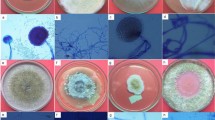Abstract
Fungi have been used for medicinal purposes for long time by Asian countries, being a putative source of powerful new phytopharmaceuticals such as polysaccharides. The aim of this study was to extract endopolysaccharides (IPS) from Ganoderma resinaceum, Phlebia rufa, and Trametes versicolor, grown under submerged culture, to compare crude IPS production, total carbohydrate, and protein yield, and to study the effect of these IPS on HepG2 cells proliferation rate. Total biomass produced by G. resinaceum, P. rufa, and T. versicolor was (in gram per liter) 3.32 ± 0.80, 5.42 ± 0.58, and 4.2 ± 1.29 and the IPS yield (as the biomass percent) was 9.9 ± 0.05, 29.0 ± 6.3, and 9.1 ± 3.1 %, respectively. Characterization of IPS has shown different proportion between total sugar and protein being, on average 6.04, 10.74, and 22.62, for G. resinaceum, T. versicolor, and P. rufa, respectively. The IPS effect, at 50, 100, and 200 μg mL−1 on HepG2 cell growth and viability was negligible for G. resinaceum and P. rufa but, in the case of T. versicolor, 200 μg mL−1 of IPS evoked 40 % reduction on cell growth. The results suggest that the intracellular polysaccharides from T. versicolor are a potential source for bioactive molecules with anti-proliferative properties.


Similar content being viewed by others
References
Lindequist, U., Niedermeyer, T. H. J., & Julich, W.-D. (2005). Evidence-based Complementary and Alternative Medicine, 2, 285–299.
Ramberg, J. E., Nelson, E. D., & Sinnott, R. A. (2010). Nutritional Journal, 9, 1–22.
El-Mekkawy, S., Meselhy, M. R., Nakamura, N., Tezuka, Y., Hattori, M., Kakiuchi, N., et al. (1998). Phytochemistry, 49, 1651–1657.
Eo, S. K., Kim, Y. S., Lee, C. K., & Han, S. S. (1999). Journal of Ethnopharmacology, 68, 129–136.
Hirasawa, M., Shouji, N., Neta, T., Fukushima, K., & Takada, K. (1999). International Journal of Antimicrobial Agents, 11, 151–157.
Josef, S., Sabulal, B., George, V., Smina, T. P., & Janardhanan, K. K. (2009). Scientia Pharmaceutica, 77, 111–121.
Berovic, M., Habijanic, J., Zore, I., Wraber, B., Hodzar, D., Boh, B., et al. (2003). Journal of Biotechnology, 103, 77–86.
Yuen, J. W. M., Gohel, M. D. I., & Ng, C. F. (2011). Journal of Ethnopharmacology, 135, 711–718.
Kimura, Y. (2005). In vivo, 19, 37–60.
Lee, J. S., Kim, M. O., Cho, K. Y., Cho, J. H., Chang, S. Y., & Nam, D. H. (2006). Journal of Microbiology, 44, 29–34.
Sliva, D. (2003). Integrative Cancer Therapies, 2, 358–364.
Chen, C. F., Yang, X. T., Li, X. Q., Mi, K., & Yang, K. Y. (2007). Wei Sheng Wu Xue Bao. (Acta Microbiologica Sinica), 47, 628–633.
Boddy, L., & Rayner, A. D. M. (1983). Transactions of the British Mycological Society, 80, 437–448.
Dinis, M. J., Bezerra, R. M. F., Nunes, F., Dias, A. A., Guedes, C. V., Ferreira, L. M. M., et al. (2009). Bioresource Technology, 100, 4829–4835.
Tang, Y. J., & Zhong, J. J. (2002). Enyzme and Microbial Technology, 31, 20–38.
Silva, M. L. C., Martinez, P. F., Izeli, N. L., Silva, I. R., Vasconcelos, A. F. D., & Cardoso, M. S. (2006). Quimica Nova, 29, 85–92.
Krcmar, P., Novotny, C., Marais, M.-F., & Joseleau, J. P. (1999). International Journal of Biological Macromolecules, 24, 61–64.
Rau, U., Kuenz, A., Wray, V., Nimtz, M., Wrenger, J., & Cicek, H. (2009). Applied Microbiology and Biotechnology, 81, 827–837.
Jiménez-Medina, E., Berruguilla, E., Romero, I., Algarra, I., Collado, A., Garrido, F., et al. (2008). BMC Cancer, 8, 78.
Dubois, M., Gilles, K. A., Hamilton, J. K., Rebers, P. A., & Smith, F. (1956). Analytical Chemistry, 28, 350–356.
Bradford, M. M. (1976). Analytical Biochemistry, 72, 248–254.
Lee, W. Y., Park, Y., Ahn, J. K., Ka, K. H., & Park, S. Y. (2007). Enzyme and Microbial Technology, 40, 249–254.
Chen, L., Pan, J., Li, X., Zhou, Y., Meng, Q., & Wang, Q. (2011). International Immunopharmacology, 11, 255–259.
Kim, Y. O., Park, H. W., Kim, J. H., Lee, J. Y., Moon, S. H., & Shin, C. S. (2006). Life Sciences, 79, 72–80.
Acknowledgments
This work was supported by European Union Funds (FEDER/COMPETE—Operational Competitiveness Programme), by national funds (FCT—Portuguese Foundation for Science and Technology) under the project FCOMP-01-0124-FEDER-022696, and by a research project grant (PEst-C/AGR/UI4033/2011) to AMS, DLS, AAD, and RMB. We acknowledge Professor Carlos Palmeira (University of Coimbra, Portugal) for supplying the HepG2 cells.
Author information
Authors and Affiliations
Corresponding author
Rights and permissions
About this article
Cite this article
Silva, A.M., Miranda, A., Fernandes, E. et al. Endopolysaccharides from Ganoderma resinaceum, Phlebia rufa, and Trametes versicolor Affect Differently the Proliferation Rate of HepG2 Cells. Appl Biochem Biotechnol 169, 1919–1926 (2013). https://doi.org/10.1007/s12010-013-0107-4
Received:
Accepted:
Published:
Issue Date:
DOI: https://doi.org/10.1007/s12010-013-0107-4




